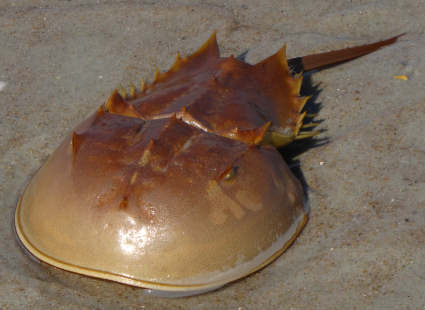
When I was infected by COVID-19, it wasn’t my lungs that suffered. It was my heart. And when my daughter was born, it was a malformed heart that threatened her life. That’s why learning about the heart and about the circulatory systems of other species and humans so intrigues me.
In Bill Schutt’s new book, “Pump: A Natural History of the Heart” he describes how our circulatory system evolved within multicellular organisms going back over 500 million years.
Some interesting facts you may not be aware of:
- The Horseshoe Crab is the closest living thing to the Trilobites that first emerged in the Cambrian seas over 500 million years ago. Horseshoe Crabs have been on the planet for 425 million years. This species exhibits common animal features including eyes, gills or lungs, a mouth, legs, genitalia and a heart. The latter is long and tubular. and when it absorbs oxygen through its gills, it’s carried through the body by blue blood, not red. That’s because Horseshoe Crabs have a circulatory system that processes oxygen and transports it using hemocyanin, a copper-based protein rather than iron-based hemoglobin.
- Insects are heartless. That’s not a comment about the way they interact with the rest of the world but rather a fact about their anatomy and physiology. They have no equivalent to a heart inside them. Instead, they use a specialized muscle that exhibits enough contractile movement to push around blood-like hemolymph to oxygenate their bodies.
- Earthworms are heartless too. Where insects have a single set of contracting muscles, earthworms have five different sets to help circulate oxygen throughout their length.
- An Octopus resembles a Horseshoe Crab in one respect. It also evolved a copper oxygen-transport protein and blue blood. But the resemblance ends there because an octopus is much closer in kinship to a snail than a crab. And an octopus, and their close cousins, squid and cuttlefish, have three hearts, one to circulate blood throughout their many-tentacled bodies, and two to pump blood to and from their gills. The three hearts make up for the fact that hemocyanin is less efficient in transporting oxygen than hemoglobin. To compensate, the octopus circulates its blood under higher pressure to ensure it can keep up its more active lifestyle than that of a Horseshoe Crab.
- The giraffe, on the other hand, has a heart that generates extremely high blood pressure to ensure it can go all the way up its long neck to the brain. Giraffe blood pressure is twice that of the average human.
- Hummingbirds have hearts that beat up to 1,260 times a minute when in flight. At rest, the rate slows to between 50 and 180 beats per minute. And on cold nights they enter a torpor-like state resembling hibernation with the heart slowing even further.
- Bats are the champions of variable heart rates, going from 200 to 1,000 beats per minute. The energy they expend in flight and feeding causes their heart rates to climb. But when at rest they have evolved an ability to rapidly slow their hearts. When bats hibernate their heart rate can slow to 20 beats per minute. Scientists believe that the variable heart rate makes bats a good reservoir host for novel viruses and are attempting to find a correlation between their unusual physiological ability and viral loads.
- A group of amphibians called plethodontids which comprise nearly 700 species of salamander, lack lungs and gills. Instead, they absorb oxygen through the skin using a near-surface network of capillaries (tiny blood vessels) that capture 90% of oxygen uptake needs and release 97% of the waste carbon dioxide. These animals need their skin to remain moist at all times or they will suffocate.
- Then there is the sea squirt, an invertebrate ocean filter-feeder that has an internal pump resembling our heart in some ways. It is simpler in shape and only has one chamber which contracts from one end to the other, then reversing in direction every two to three minutes. It does this powered by specialized pacemaker cells.
What is so fascinating about Schutt’s journey through the origins of the heart to the muscle contained in ourselves, is how well it illustrates the natural selection process of evolutionary convergence. Animate life has found numerous ways to accomplish similar outcomes. Our heart has four chambers. The heart of a fish has two. Amphibians and most reptiles have three. Four-chambered hearts like ours are found in crocodilians, birds and mammals.
Evolutionary convergence can be seen here with different species achieving similar outcomes through development over time of analogous anatomical structures, and even alternate chemistries. It is a fascinating field of study that goes well beyond the convergence examples found in science textbooks I read: dolphins and fish, and bats and birds. And blue-blooded takes on a whole new meaning when you think about Horseshoe Crabs and octopuses.








